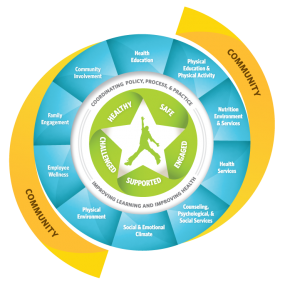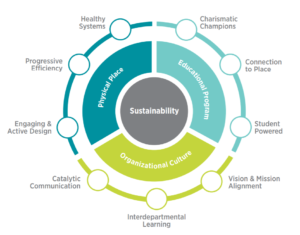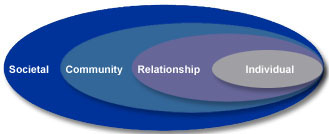Whole School, Whole Child, Whole Community & Other Theories that Inform Our Healthy Schools Work!
This month, we would like to take a deep dive into the theories that inform our public health practice. Theories help inform our work, guide our decision-making, and hold us accountable to a process that is equitable, inclusive, and responsible. When we’re thinking about improving the health, safety, and quality of the learning environments in our Pennsylvania schools, we want to be intentional in creating sustainable impacts and changing school cultures.
What does it mean when you say Healthy Schools is a public health program?
Public health is a discipline focused on preventing disease and promoting health for different populations of people. Instead of delivering care in a clinical setting, public health practitioners deliver care in a community setting. Instead of focusing on curing disease, public health practitioners spend most of their energy preventing disease through data collection, education, programming, and connecting families to resources. So when we say that Healthy Schools is a public health program, it means that we create programming that is based on the best available scientific evidence, that serves the entire school community, and that is focused on preventing environmental health hazards in the spaces where we grow, learn, play, and work.
Why do theories matter in public health programming?
Social and behavioral theories provide a framework for understanding why health disparities exist among different members in our communities. As an organization focused on protecting children’s health, we know that children are uniquely vulnerable to environmental hazards because of their developing bodies and behaviors. We want to reduce and eliminate the health risks so that children can have the best opportunity to thrive and grow.
For each theory below, we will break down its main components and discuss how we’re using theory to guide our principles in setting priorities and involving community members for Healthy Schools programming.
Whole School, Whole Child, Whole Community
According to the Centers for Disease Control, “The Whole School, Whole Community, Whole Child, or WSCC model, is CDC’s framework for addressing health in schools. The WSCC model is student-centered and emphasizes the role of the community in supporting the school, the connections between health and academic achievement and the importance of evidence-based school policies and practices. The WSCC model has 10 components:

- Physical education and physical activity.
- Nutrition environment and services.
- Health education.
- Social and emotional school climate.
- Physical environment.
- Health services.
- Counseling, psychological and social services.
- Employee wellness.
- Community involvement.
- Family engagement.
The Whole School, Whole Child, and Whole Community theory puts children’s health at the center. It focuses not only on what’s available to children – physical activity and health services, for example – but also what social supports are necessary for raising healthy children. Having other stakeholders involved, such as staff, teachers, parents, administrators, and community members really speaks to the proverb that ‘it takes a village to raise a child’. At Healthy Schools PA, we use this framework to map what assets and strengths are available to a specific school community, and which areas we need to invest and improve upon to support the health of the whole child, the whole school, and ultimately, the whole community!
Whole School Sustainability Framework
The Center for Green Schools, with other collaborative partners, first put forth the Whole School Sustainability Framework in 2016. According to the report, “The framework is founded on the imperative that in order to be successful, sustainability requires a whole-system approach.
A Whole-School Sustainability approach requires individuals from across an organization to work together—it cannot be accomplished in a silo. This system framework is organized into the three components of schools: organizational culture, physical place, and educational program. Within these three components, we have identified a total of nine principles. ”

At Healthy Schools PA, we know that in order to promote healthy schools, we also need to be thinking thoughtfully about what constitutes an environment. More than just the school building, learning environments are shaped by the relationships and systems within it – which is why we love the Whole School Sustainability Framework’s inclusion of Education Programs and Organizational Culture. Without support from school administrators and students, healthy schools are not possible. Not only do we want to create healthier learning environments for all students – we also want to promote a culture of sustainability where schools play an active role in resource conservation and environmental stewardship!
Socioecological Model
The last theory we’ll share is the Socioecological Model – a hallmark of community-based public health practice! The Socioecological Model shows how health happens at all levels in which our society is organized – at the individual, intra-personal (relationships), community, and societal levels.
On the Rural Health Information Hub, they explain the levels of this model below:
- Intrapersonal/individual factors, which influence behavior such as knowledge, attitudes, beliefs, and personality.
- Interpersonal factors, such as interactions with other people, which can provide social support or create barriers to interpersonal growth that promotes healthy behavior.
- Institutional and organizational factors, including the rules, regulations, policies, and informal structures that constrain or promote healthy behaviors.
- Community factors, such as formal or informal social norms that exist among individuals, groups, or organizations, can limit or enhance healthy behaviors.
- Public policy factors, including local, state, and federal policies and laws that regulate or support health actions and practices for disease prevention including early detection, control, and management.

We know that change does not happen in a vacuum. Change always happens in conversations within different systems in a school. The most effective public health programs work at all levels of the socioecological model. At Healthy Schools PA, we strive to cultivate individual relationships with school stakeholders, including parents, students, educators, and administrators. We train and educate community members on environmental health hazards, and we also advocate for societal or policy level solutions to protect children’s health!
Sources:
https://www.cdc.gov/healthyschools/wscc/index.htm
https://centerforgreenschools.org/sites/default/files/resource-files/Whole-School_Sustainability_Framework.pdf
https://www.ruralhealthinfo.org/toolkits/health-promotion/2/theories-and-models/ecological
Delayed School Start Dates Underscore Need for Proper Indoor Air Quality
Hundreds of students got unexpected news as they geared up for back to school – their first day for the 2018-2019 school year was pushed back. While many kids were celebrating an extended summer vacation, many parents and community members were left with questions about the conditions of school buildings.
The cause of the delay? Problems with indoor air quality, mold, and damage caused from the hot weather. These issues affected school start dates in seven districts across southwestern Pennsylvania, including:
| School District | Schools | Environmental Hazard Found | Action Taken |
| Shaler | High School | Spores found in air quality tests | Delayed opening to Sept. 4 |
| Highlands | High School | Mold | Delayed opening to Sept. 4 |
| Plum-Borough | High School, Obleck Middle School | Mold found in 3 classrooms | Delayed opening for the district to Sept. 4 |
| Mt. Pleasant | Junior-Senior High School | Water damage around windows causing mold | Delayed opening to Sept. 4; remediation on going through Reynold’s Restoration |
| Pine-Richland | Hance Elementary School | Mold on ceilings | Moved to Eden Hall Elementary School while remediation occurs |
| Southmoreland | High School | Air quality | Remediation ongoing |
| North Allegheny | McKnight Elementary School | Mold in classrooms | Children moved from affected areas; remediation on-going by AGX Environmental Consultants |
While these issues are not uncommon at the end of the summer, there are ways schools and school districts can prevent them. The Environmental Protection Agency published guidelines, titled “Tools for Schools” that help schools create and implement healthy indoor air quality plans. Under these guidelines are several resources intended to help members of a school community – from teachers, to students; to parents and facilities directors – to make informed decisions to protect children’s health.
Children spend up to 1,000 hours in school every year. We must all do what we can to protect the environments in which they live, learn, and play. The first step is getting informed and pursuing preventive strategies, rather than just remediation once a problem has been identified. Together, we can take important steps to ensure delayed school starts are prevented.
Back to School Updates
Pennsylvania New School Code
The new School Code was passed by the General Assembly, signed off by Gov. Tom Wolf, and includes testing for the presence of lead in school drinking water for the 2018-2019 school year. The School Code now states that if testing results show lead levels that are unacceptable according to U.S. Environmental Protection Agency standards, the school must produce a remediation plan and provide alternative drinking water until retesting reveals acceptable levels. If a school district chooses to forgo the testing of their water this school year, the school district must hold a public hearing to further discuss lead within school facilities. To read the full bill (Section 742),
CLICK HERE!
Two Western PA Schools Honored as Green Ribbon Schools
In 2017-2018 we had 30 schools throughout Allegheny County participate in our program. Two of our schools even went on to receive designations as 2018 Green Ribbon Schools: Mount Lebanon High School and Wexford Elementary School. Both of these schools participated in our Healthy Schools Recognition Program for a number of years and received our highest level of High Honor Roll with Distinction!
Please congratulate these two fine schools and all they have accomplished! They will be recognized in Washington, DC on September 19, 2018 for their Green Ribbon School status!
Back to School Supplies
How can we ensure this school year is as healthy for your students and staff as possible? There are several ways Healthy Schools PA can help you!
We have prepared this “Healthy Back to School Checklist” to provide you with tools and tips for choosing safer products to fill your classrooms. And check out US PIRG Education Fund’s “Safer School Supplies: Shopping Guide” to ensure the right products come into your school buildings!
Take Action Today!
If your school is in need of testing for lead in drinking water, please see our 1000 Hours a Year grant program! We have a limited number of mini grants available!
Chronic Absenteeism
It’s as elemental as it gets — keeping kids in the classroom means they have more opportunities to learn. That’s one reason why daily attendance has historically been such an important measure for schools. However, while no one questions this fact, it turns out that measuring kids in class may not be as straightforward as most of us assume.
Back to School
It’s that time of year again, summer is winding down and that to back to school feeling is in the air. Stores are stocked up on school supplies and between new pens, pencils, binders and lunch boxes, it can be difficult to decide which products are healthy and safe for school students. To make choosing school supplies easy for parents and students, Healthy Schools PA has put together a ” Green Guide for Back to School” to make sure this school year will be a safe and healthy!
Fragrance-Free Schools Video Contest Winners:
1st Place Winner
Souderton Area High School
Watch Video Here
Runner-Up
Livia Molinaro
Franklin Regional School District
Watch Video Here
Background:
Every day students suffer because of allergies and asthma triggered by fragrances. In fact, about 30% of the population suffers from allergies and is, in some degree, affected by fragrances. Approximately 5 to 10% of the population are extremely sensitive to these scented products—and these sensitivities can have a severe impact on the lives of both adults and students.
For more information on Fragrance-Free Schools, click here!
Special thanks to the Highmark Foundation for sponsoring this contest!
View the informative webinar “IPM and Schools: Lice, Bed Bugs and Beyond” here:
Lyn Garling and Michelle Niedermeier, both with the PA Integrated Pest Management Program, present information regarding best management practices in the school setting. Lyn and Michelle have extensive experience in this field and will cover all topics related to pest management in the school setting. Questions regarding pest management? This is the session for you! This webinar is relevant for all audiences: parents, teachers, facility directors and employees, and administration. Contact us at 412.404.2872 or info@healthyschoolspa.org to receive more information.
Webinar link: http://services.choruscall.com/links/wfahe150407.html
